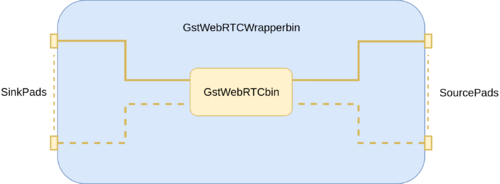Difference between revisions of "GStreamer WebRTC Wrapper/Introduction/GstWebRTCWrapper Basics"
Jcaballero (talk | contribs) |
Jcaballero (talk | contribs) |
||
| Line 3: | Line 3: | ||
</noinclude> | </noinclude> | ||
| − | This wiki introduces WebRTC technology support in the GStreamer framework. GStreamer provides an element called GstWebRTCbin. RidgeRun extends the | + | This wiki introduces WebRTC technology support in the GStreamer framework. GStreamer provides an element called GstWebRTCbin. RidgeRun extends the support provided by GStreamer with GstWebRTCWrapperbin. |
== What is GstWebRTCWrapperbin? == | == What is GstWebRTCWrapperbin? == | ||
Revision as of 17:12, 30 June 2023
| GStreamer WebRTC Wrapper |
|---|
 |
| Introduction |
| Architecture |
| Evaluating GstWebRTCWrapper |
| Getting the Code |
| GStreamer Pipelines |
| Other WebRTC RidgeRun products |
| Contact Us |
This wiki introduces WebRTC technology support in the GStreamer framework. GStreamer provides an element called GstWebRTCbin. RidgeRun extends the support provided by GStreamer with GstWebRTCWrapperbin.
What is GstWebRTCWrapperbin?
GstWebRTCWrapperbin is a GStreamer plug-in that wraps the GstWebRTCbin element developed by GStreamer providing more flexibility to be integrated on multiple WebRTC applications using customized signaling protocols and ICE serving standards.
Why GstWebRTCWrapperbin?
Other WebRTC solutions will automatically detect the video and audio sources, as well as the decoders/encoders and other elements to be used to build the pipeline. This may be convenient for many applications, but the result limiting for several other use cases. To mention some of them:
- Extend existing pipeline to support WebRTC streaming.
- Use non-standard pipeline configurations.
- High performance pipeline tuning for resource critical systems
- Dynamic stream handling in a running pipeline.
- Fine grained pipeline control.
- Quick gst-launch prototyping.
GstWebRTCWrapperbin was developed based on these criteria. As such, the plug-in is ideal for:
- Embedded platforms.
- Existing media servers/applications.
- Multiple Signaling protocols.
- Advanced multimedia solutions.
- Speed up the development.
